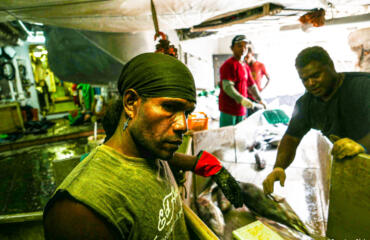
Areas of dieback where so-called “cinnamon fungus” has invaded bushland. PIC: David Cahill
The “cinnamon fungus” is listed in the top 100 of the world’s most invasive species and, according to latest government estimates, has destroyed more than one million hectares of vegetation.
Deakin University biologist David Cahill said that, despite its name, the invader was not a fungus but an algae-like oomycete or “water mould” that lives in the soil and destroys plant roots.
“It’s called cinnamon fungus because it was isolated from cinnamon trees from South-East Asia and also because the plants go a cinnamony brown colour,” Professor Cahill said.
“Phytophthera can cause a complete eco-system collapse, which has been the case in the Stirling Ranges in Western Australia, the Brisbane Ranges, Victoria, and some parts of the Grampians and Wilsons Promontory. It’s pretty much present in every state and territory across Australia.”

The plant pathogen, “Phytophthora cinnamomi”, was introduced during European settlement and became a threat in the 1960s.
“Many native plants including banksias, eucalypts, grass trees, heaths and bush peas are vulnerable to infection,” Prof Cahill said. “Major over-story plants such as the eucalypts and banksias will also die-off.”
Wilsons Promontory, a popular tourist destination at the southernmost tip of Victoria, has been heavily affected by the disease.
Signs tellings visitors to stick to walking trails were erected as part of the Victorian Government’s 2008 Land Management Strategy.
Wilsons Promontory ranger Emily Green said the pathogen can be transferred on boots, vehicles and animals, and by water moving through the soil.
“We experienced a severe flood in the Prom in March 2011, where more than 375mm of rain was recorded in Tidal River in 24 hours, and an estimated 500mm in some of the mountainous areas of the Prom,” she said.
After the flood, staff noticed the disease had spread, causing serious impact in some areas.
Wilsons Promontory does not have boot-wash stations, which have been installed in the Brisbane Ranges and other parks along the Otway coast as part of the State Government’s management strategy.
“As we do not permit off-track hiking without approval at the Prom, we do not provide this facility,” she said.
Despite this, Prof Cahill said the disease had reached the top of Mt Oberon, most likely spread by hikers.
To manage the disease “you can spray [phosphite-potassium phosphonate] on the plant and this protects them for some time,” he said. “The trouble is you have to keep spraying it continuously.
“We did some aerial spraying in Anglesea heathlands a few years ago as part of another project . . . and that seemed to work for a reasonable amount of time.”

Prof Cahill said the phosphite did not kill the fungus. Instead, it boosted the immune system of the infected plants so they were able to survive an attack.
In agriculture, avocados, pineapples and macadamias were highly susceptible to the cinnamon fungus.
“If we didn’t use phosphite the avocado industry in Australia wouldn’t be in existence,” he said.
Avocados Australia spokeswoman Anna Petrou said the avocado industry had been striving to manage the “soil-borne water mould” since the industry’s beginnings.
“It is a potential threat to production and a lot of activity has been, and continues to be, looking at addressing and managing it,” she said.
The industry body was working with federal and state governments to help growers manage the problem.
Ms Petrou said the Queensland Department of Agriculture and Fisheries had produced a poster informing growers of how best to control the cinnamon fungus. She said growers could use different methods depending on whether they were “conventional or organically certified growers”.
Meanwhile, Prof Cahill and his students are examining what DNA component makes some species of plant less susceptible to the disease in a bid to identify whether they could boost their immunity.
He said the disease liked warm and wet conditions, which meant that if climate change was to lead to a reduction in rainfall, there could be some relief from the fungus. The consequences, however, of increased rainfall would be “really bad”.



